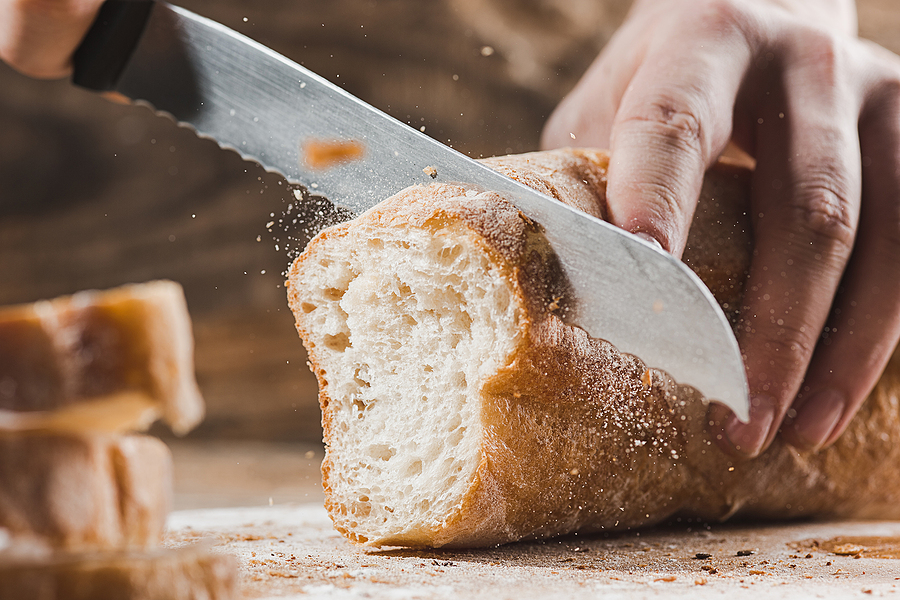With so much breaking news this summer, not to mention family travel and fun time, chances are you missed it.
Sliced Bread Day has come and gone.
It probably wasn’t on your calendar. That’s because it’s only observed every July 7 in the sleepy little town of Chillicothe, Mo., birthplace of an innovation that’s likely in your kitchen right now. Here’s how it got there.
Back in the early 20th Century, life was rough for housewives. Electricity was gradually making its way into homes, powering changes that would forever transform domestic life. But those changes were still in their infancy. The biggest impact was being felt in the pantry.
Prepared goods sold in cans and jars were becoming popular. Though they’d been around for years, they had often tasted flat. Now, innovators like Heinz (of 57 varieties fame), Campbell’s (beans and soups), and Del Monte (fruit and vegetables) were increasing product quality while also lowering prices.
Additionally, wives were being tempted by another bit of culinary progress. Store-bought bread.
If you’ve ever mixed dough, kneaded, and baked it, you know breadmaking is a hot, tiresome, and time-consuming process. We don’t mean making a loaf now and then for fun; we’re talking about having one day of each week set aside just for baking. That was especially true for large farm families with lots of kids who (especially teenagers) consumed bread like it was going out of style. Keeping up with the relentless demand made many moms feel like they were running on a treadmill.
The dawn of the 20th century saw the arrival of industrial bakeries. They turned out loaves on an assembly line, making them affordable for working-class families.
And Otto Rohwedder had an idea for making that good thing even better.
He started his career as a jeweler in St. Joseph, Mo., eventually owning three stores there. In between setting precious tones and fixing broken watches, he tinkered with machines on the side. He came to believe he could devise one that would automatically slice bread. Up till then, it had to be cut by hand, with each slice varying in thickness. Rohwedder imagined a mechanism that made clean, uniform slices with each piece identical to the others.
He became so obsessed with his vision that once he had a working device, he sold his stores and created a company to produce it. Things were looking good… until 1917, when his dream literally went up in smoke. A fire destroyed his plant, prototype, and blueprints.
Most men would have given up. But not Otto Rohwedder. He started over from scratch and created another working model. Now flat broke, it took him several years to round up the capital to manufacture it. But he never lost sight of his revolutionary vision. By 1927, he was ready to give it another shot. With an added feature.
His new machine not only sliced the bread, but also wrapped the loaf once it was finished. Bakers immediately recognized a big time and cost-saver. Yet they still balked; would housewives go for it?
Frank Bench knew a good thing when he saw one. He bought the first of the new-fangled machines for his Chillicothe Baking Company and put it to work on his “Kleen Maid Sliced Bread” on July 7, 1928. He advertised with the snappy slogan, “The greatest step forward in the baking industry since bread was wrapped.”

(Another bakery in Battle Creek, Mich., insists it was first. However, historians have been unable to verify that claim. Meaning Battle Creek must content itself with being famous for a certain breakfast staple.)
A St. Louis baker bought the second machine, and Rohwedder was up and running. In 1930, Wonder Bread took the miraculous change nationwide. It was such an immediate runaway success that by 1933, just five years after hitting the market, 80 percent of all bread sold in the U.S. was sliced.
Which led to the famous saying, “It’s the greatest thing since sliced bread!”
From then on, whole loaves have had a backseat to the sliced variety.
Washington got a reminder of its immense popularity during World War II. Agriculture Secretary Claude Wickard, who was doing double duty as National Food Administrator, announced sliced bread would be banned starting Jan. 18, 1943. It required heavier wrapping paper, bureaucrats claimed, which was somehow hampering the war effort.
The public outcry was instant and deafening. Americans endured rationing of gasoline, meat, and sugar. Men would go without new cars, and women willingly gave up nylon stockings. But folks drew the line at sliced bread. The government swiftly surrendered.
And so the machines still hum away today, cutting their way through loaf after loaf with surgical precision amid a demand that shows no sign of waning.
Hopefully, next July 7, we’ll all remember the reliable slicing machine and the remarkable inventor who refused to give up on it.
Perhaps with a “toast?”


